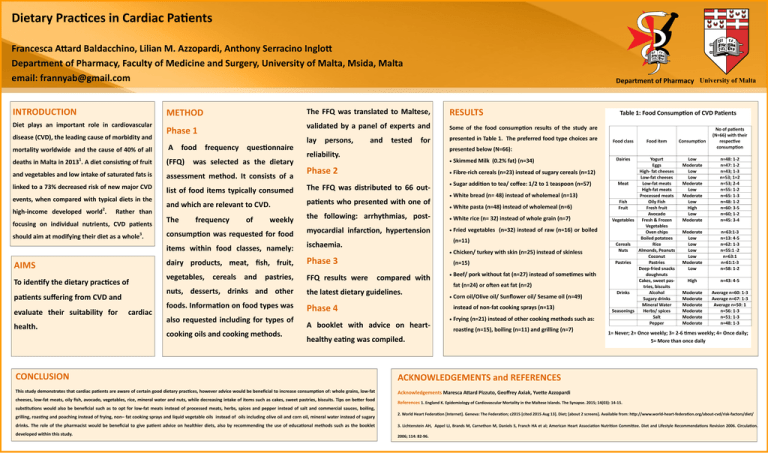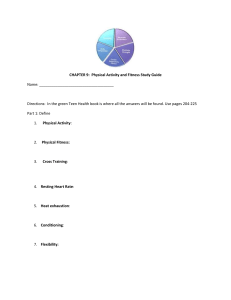Dietary Practices in Cardiac Patients
advertisement

DEPARTMENT OF PHARM ACY UNIVERSI TY OF MA LTA Dietary Practices in Cardiac Patients Francesca Attard Baldacchino, Lilian M. Azzopardi, Anthony Serracino Inglott Department of Pharmacy, Faculty of Medicine and Surgery, University of Malta, Msida, Malta email: frannyab@gmail.com INTRODUCTION Diet plays an important role in cardiovascular disease (CVD), the leading cause of morbidity and mortality worldwide and the cause of 40% of all 1 deaths in Malta in 2013 . A diet consisting of fruit and vegetables and low intake of saturated fats is linked to a 73% decreased risk of new major CVD events, when compared with typical diets in the 2 high-income developed world . Rather than focusing on individual nutrients, CVD patients 3 should aim at modifying their diet as a whole . AIMS To identify the dietary practices of patients suffering from CVD and evaluate their suitability for health. cardiac Department of Pharmacy University of Malta METHOD The FFQ was translated to Maltese, RESULTS Phase 1 validated by a panel of experts and Some of the food consumption results of the study are lay presented in Table 1. The preferred food type choices are A food frequency questionnaire (FFQ) was selected as the dietary assessment method. It consists of a persons, and tested for reliability. Phase 2 Skimmed Milk (0.2% fat) (n=34) Fibre-rich cereals (n=23) instead of sugary cereals (n=12) Sugar addition to tea/ coffee: 1/2 to 1 teaspoon (n=57) White bread (n= 48) instead of wholemeal (n=13) White pasta (n=48) instead of wholemeal (n=6) list of food items typically consumed and which are relevant to CVD. patients who presented with one of The weekly the following: arrhythmias, post- White rice (n= 32) instead of whole grain (n=7) consumption was requested for food myocardial infarction, hypertension Fried vegetables (n=32) instead of raw (n=16) or boiled items within food classes, namely: ischaemia. dairy products, meat, fish, fruit, Phase 3 of vegetables, cereals and pastries, FFQ results were (n=11) compared with the latest dietary guidelines. foods. Information on food types was Phase 4 cooking oils and cooking methods. Chicken/ turkey with skin (n=25) instead of skinless (n=15) nuts, desserts, drinks and other also requested including for types of Beef/ pork without fat (n=27) instead of sometimes with fat (n=24) or often eat fat (n=2) Corn oil/Olive oil/ Sunflower oil/ Sesame oil (n=49) instead of non-fat cooking sprays (n=13) A booklet with advice on heart- Frying (n=21) instead of other cooking methods such as: roasting (n=15), boiling (n=11) and grilling (n=7) healthy eating was compiled. CONCLUSION ACKNOWLEDGEMENTS and REFERENCES This study demonstrates that cardiac patients are aware of certain good dietary practices, however advice would be beneficial to increase consumption of: whole grains, low-fat Acknowledgements Maresca Attard Pizzuto, Geoffrey Axiak, Yvette Azzopardi cheeses, low-fat meats, oily fish, avocado, vegetables, rice, mineral water and nuts, while decreasing intake of items such as cakes, sweet pastries, biscuits. Tips on better food Food class Food item Consumption presented below (N=66): The FFQ was distributed to 66 out- frequency Table 1: Food Consumption of CVD Patients Dairies Yogurt Eggs High- fat cheeses Low-fat cheeses Meat Low-fat meats High-fat meats Processed meats Fish Oily Fish Fruit Fresh fruit Avocado Vegetables Fresh & Frozen Vegetables Oven chips Boiled potatoes Cereals Rice Nuts Almonds, Peanuts Coconut Pastries Pastries Deep-fried snacks doughnuts Cakes, sweet pastries, biscuits Drinks Alcohol Sugary drinks Mineral Water Seasonings Herbs/ spices Salt Pepper No of patients (N=66) with their respective consumption Low Moderate Low Low Moderate Low Moderate Low High Low Moderate n=48: 1-2 n=47: 1-2 n=43; 1-3 n=53; 1=2 n=53; 2-4 n=55: 1-2 n=65: 1-3 n=48: 1-2 n=60: 3-5 n=60; 1-2 n=45: 3-4 Moderate Low Low Low Low Moderate Low n=63:1-3 n=13: 4-5 n=62: 1-3 n=55:1 -2 n=63:1 n=61:1-3 n=58: 1-2 High n=43: 4-5 Moderate Moderate Moderate Moderate Moderate Moderate Average n=60: 1-3 Average n=67: 1-3 Average n=50: 1 n=56: 1-3 n=51: 1-3 n=48: 1-3 1= Never; 2= Once weekly; 3= 2-6 times weekly; 4= Once daily; 5= More than once daily References 1. England K. Epidemiology of Cardiovascular Mortality in the Maltese Islands. The Synapse. 2015; 14(03): 14-15. substitutions would also be beneficial such as to opt for low-fat meats instead of processed meats, herbs, spices and pepper instead of salt and commercial sauces, boiling, grilling, roasting and poaching instead of frying, non– fat cooking sprays and liquid vegetable oils instead of oils including olive oil and corn oil, mineral water instead of sugary 2. World Heart Federation [Internet]. Geneva: The Federation; c2015 [cited 2015 Aug 13]. Diet; [about 2 screens]. Available from: http://www.world-heart-federation.org/about-cvd/risk-factors/diet/ drinks. The role of the pharmacist would be beneficial to give patient advice on healthier diets, also by recommending the use of educational methods such as the booklet 3. Lichtenstein AH, Appel LJ, Brands M, Carnethon M, Daniels S, Franch HA et al; American Heart Association Nutrition Committee. Diet and Lifestyle Recommendations Revision 2006. Circulation. developed within this study. 2006; 114: 82-96.


